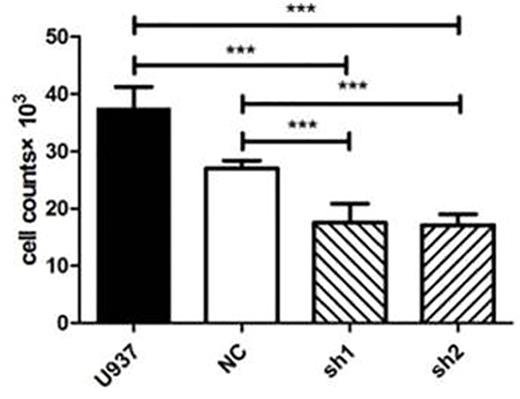Abstract
Background: Acute monocytic leukemia(AML-M5), a common hematological malignancy, is serious harm to human health with dangerous clinical prognosis and extramedullary infiltration. Monocytic leukemia associated antigen-34(MLAA-34) gene (GenBank no. AT288977.2) was first discovered in M5 in an effort to identify monocytic leukemia associated antigens by serological identification of antigens by recombinant expression cloning (SEREX). Studies showed that MLAA-34 gene was a new anti-apoptotic molecule associated with acute monocytic leukemia cell U937 through JAK/STAT3 and Wnt signal pathways. Previous clinical studies showed that MLAA-34 was highly expressed in M5 patients involved with extramedullary infiltration and poor survival rate. Further researches on MLAA-34 revealed that MLAA-34 protein expressed in very few cases of lung, colon and stomach cancer and overall survival of these patients were significantly poorer.
Objective: This study aims to explore the expression of MLAA-34 in variety of acute myeloid leukemic patients and its correlation with extramedullary infiltration so as to further identify mechanisms of tumor invasive of MLAA-34.
Method: Collected bone marrow and peripheral blood samples of 52 newly diagnosed acute myeloid leukemic patients and 14 healthy volunteers, then RT-PCR based on Taqman probe technology was constructed to detect MLAA-34 mRNA and found the relationship between the MLAA-34 expression and extrameduulary infiltration. Blood cell lines including monocytic leukemia cells(THP1, U937), promyelocytic leukemia cell(NB4), myeloid leukemia cell(K562), lymphocytic leukemia cells(RS4;11, Jurkat), myeloma cells(RPMI8226, U266,H929)and solid tumor cells including hepatoma carcinoma cells(MHCC97H, Hep3B, SMMC7721), colon cancer cells(SW480, SW620), breast cancer cells(MCF7, MDA-MB 231), lung carcinoma cells(A549, PC9, H1975) were tested. The total RNA was extracted from cells and patients by TRIzol Reagent (Invitrogen). RT-PCR and Western blot were performed to detect MLAA-34 mRNA and protein express. Short hairpin RNAs (shRNA) targeting MLAA-34 gene were designed and successfully transfected into U937 cells. The efficient knockdown MLAA-34 in U937 cells were constructed to observe MLAA-34 effect on tumor metastasis by transwell invasion experiment.
Results: We focused on MLAA-34 gene expression in different subtypes of acute myeloid leukemia (AML). M5 and acute myelomonocytic leukemia (M4) patients expressed high levels of MLAA-34 mRNA, which accompanied with high rates of extramedully lesion. The group of extramedullary infiltration patients presented significantly higher levels of MLAA-34 mRNA than those who did not(P<0.05). MLAA-34 mRNA and protein detected in monocytic leukemia cells(U937 and THP1) showed much higher expression levels than other blood cells and solid tumor cells. The expression of MLAA-34 were generally poor in solid tumor cells, but the high invasive solid tumor cells including colon cancer cell(SW620), hepatocarcinoma cell(MHCC97-H), breast cancer cell(MDA-MB 231) had significant higher levels than equivalent cells with low invasive ability(Figure 1). Transwell experiments detecting the invasion differences among acute myeloid leukemia cells including U937, THP1, NB4 and K562 showed that the level of MLAA-34 mRNA were positively correlated with the cell invasive ability(Figure 2). The expression vectors of MLAA-34 shRNA were successfully constructed. The counts of shRNA-MLAA-34 U937 cells significantly reduced in the lower chambers under microscope(Figure 3). These data revealed that cell invasion ability was significantly correlation with MLAA-34 level and MLAA-34 might mediate tumor invasion.
Conclusion: MLAA-34 plays an important role in extremedullay infiltration and MLAA-34 is specifically positively correlated with the invasive ability of cancer cell.
MLAA-34 mediates tumor invasion in acute myeloid leukemia cell U937.***:P<0.05
No relevant conflicts of interest to declare.
Author notes
Asterisk with author names denotes non-ASH members.




This feature is available to Subscribers Only
Sign In or Create an Account Close Modal